Peugeot 607 2005 Owner Manual
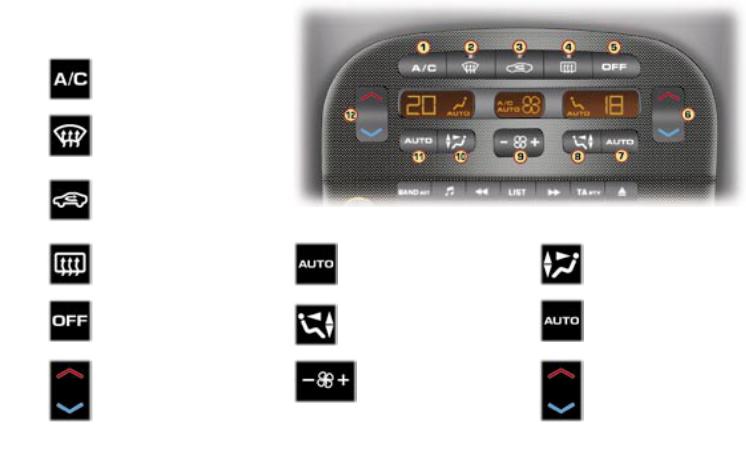
10 - Familiarisation
AUTOMATIC AIR
CONDITIONING
1.Air conditioning on/off.
2.Automatic visibility programme.
3.Air intake/air recirculation.
4. |
Rear screen and |
7. |
Driver's |
|
exterior mirrors |
|
automatic comfort |
|
demisting. |
|
programme. |
5. |
System off. |
8. |
Driver's air |
|
|
|
distribution |
|
|
|
adjustment. |
6. |
Driver's temperature |
9. |
Air flow adjustment. |
|
adjustment. |
|
|
10.Passenger air distribution adjustment.
11.Passenger automatic comfort programme.
12.Passenger temperature adjustment.
:42
 01-06-2005
01-06-2005
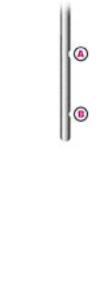
102 - Checks
CHECKING THE LEVELS
Oil level
F Check the level regularly and top up between changes. Maximum consumption is 0.5 l per 600 miles (1,000 km).
Carry out this check with the vehicle level, engine cold, using the oil level gauge on the instrument panel or the dipstick.
Dipstick
There are two marks on the dipstick:
A = maximum
Never fill past this mark. B = minimum
To maintain the reliability of engines and emission control systems, the use of additives in engine oil is prohibited.
Oil change
According to the information given in the servicing booklet.
Viscosity selection
In all cases, the oil selected must meet the manufacturer's requirements.
 01-06-2005
01-06-2005
Brake and clutch fluid level
The level must always be between the DANGER and MAXIMUM marks in the reservoir.
If the level drops substantially, contact a PEUGEOT dealer immediately.
Fluid change:
-must be carried out according to the manufacturer's servicing schedule.
-use fluids recommended by the manufacturer, which fulfil DOT4 standards.
Power steering reservoir
F Open the reservoir, with the engine cold at ambient temperature. The level should always be above the MINI mark and close to the MAXI mark.
Windscreen and headlamp wash level
For best quality cleaning and for your safety, we advise that you use products recommended by PEUGEOT (reservoir capacity 4 litres or 6.5 litres with headlamp wash).
Used oil
Prevent used oil from coming into prolonged contact with the skin.
Brake and clutch fluid is harmful to health and very corrosive.
Do not dispose of used oil, brake and clutch fluid or coolant into drains or onto the ground.

CHECKS
Battery
At the start of winter, have your battery checked by a PEUGEOT dealer.
Air filter and passenger compartment filter
Have the filter elements replaced regularly. If you drive in dusty conditions, change them twice as often.
Particulate emission filter - Additive reservoir (Diesel)
Maintenance of the particulate emission filter and filling of the additive reservoir must be carried out by a PEUGEOT dealer, according to the manufacturer's servicing schedule.
Brake pads
Brake pad wear depends on the style of driving, in particular for vehicles which are used in town, over short distances. It may be necessary to check the thickness of the pads, even between services.
Handbrake
Where the handbrake travel is too great or there is a reduction in the performance of the system, the handbrake should be adjusted. Have the system checked by a PEUGEOT dealer.
Manual gearbox
This does not need an oil change.
Have the level checked, according to the manufacturer's servicing schedule.
Automatic gearbox
This does not need an oil change. Have the level checked by a PEUGEOT dealer, according to the manufacturer's servicing schedule.
Oil filter
Change the filter regularly, in accordance with the servicing schedule.
Checks - 103
In order to check the main levels and certain components, in accordance with the manufacturer's servicing schedule, refer to the pages of the servicing booklet which correspond to your vehicle's engine.
Only use products recommended by PEUGEOT or products of equivalent quality and specification.
To ensure best performance from components as important as the power steering and the braking system, PEUGEOT selects and offers specific products.
To prevent damage to the electrical units, high pressure washing of the engine compartment is strictly prohibited.
 01-06-2005
01-06-2005
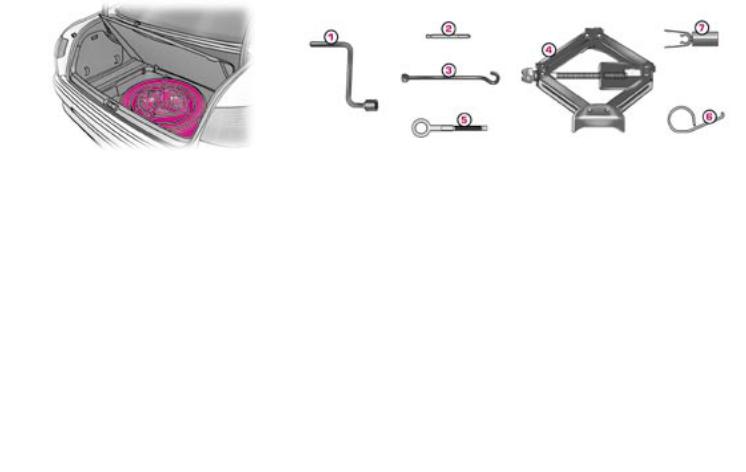
104 - Practical information
CHANGING A WHEEL
F Park the vehicle on level, stable and non-slippery ground.
F Apply the handbrake, switch off the ignition and engage first or reverse gear (position P for the automatic gearbox).
Access to the spare wheel and the jack in the boot
FDetach the luggage net.
FLift the boot carpet using the lifting hook. Secure this hook behind the boot seal.
Tools available
The following tools are located in the polystyrene holder in the centre of the spare wheel:
1 - Wheelbrace.
2 - Centralising tool.
3 - Wheelbrace extension.
4 - Jack.
5 - Removable towing eye.
6 - Alloy wheel trim remover.
7 - Trim cover tool.
Removal
F For vehicles with alloy wheels fitted with wheel trims, pull the centre trim by using tool 6 in one of the holes.
FLoosen the wheel bolts.
FTake the jack 4 from the tool kit.
FPlace the jack in one of the four locations A underneath the vehicle (the nearest one to the wheel to be changed).
FExtend the jack using wheelbrace 1 and the extension 3.
FRemove a wheel bolt at the top and fit the centralising tool 2 in its place.
FUnscrew the other bolts and remove the wheel.
 01-06-2005
01-06-2005

Fitting a wheel
F Position the wheel using the centralising tool 2 to assist you.
F Tighten the bolts by hand and remove the centralising tool.
F Partly tighten the bolts using the wheelbrace 1.
FFold the jack 4 and remove it.
FFully tighten the bolts using the wheelbrace.
FReplace the wheel trim.
For the alloy trims, position the removal hole opposite the valve.
F Put the tool holder back in position. This helps to keep the boot floor in its correct position, to prevent any deformation of the floor when loaded.
F Tighten the spare wheel securing strap to prevent noise and for your safety in the event of impact.
Practical information - 105
For your safety, always change the wheel:
-on level, stable, nonslippery ground,
-with the handbrake applied,
-with first or reverse gear engaged (position P for the automatic gearbox),
-never go underneath a vehicle which is supported only by a jack
(use a ramp).
After changing the wheel:
-have the tightening of the bolts and the tyre pressure checked by a PEUGEOT dealer as soon as possible,
-have the punctured wheel repaired and refit it to the vehicle as soon as possible,
-the steel spare wheel must only be used for a very short time.
Tyres fitted with the Tyre UnderInflation Detection System.
These wheels have a pressure sensor. Have them repaired by a PEUGEOT dealer.
 01-06-2005
01-06-2005
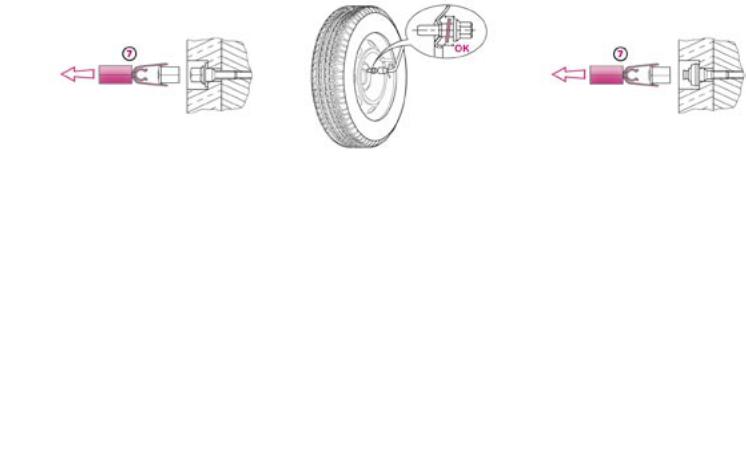
106 - Practical information
Special features of alloy wheels
Bolt covers
Alloy wheel bolts are covered by chrome trims.
Use the yellow tool 7 to remove the trims before slackening the bolts.
Fitting the spare wheel
If your vehicle is fitted with a steel spare wheel, when fitting it, it is normal to notice when tightening the bolts that the washers do not come into contact with the rim. The spare wheel is secured by the cone-shape of each bolt.
Fitting snow tyres
If you fit snow tyres mounted on steel wheels to your vehicle, it is essential to use special bolts available from your PEUGEOT dealer.
Fitting snow chains
If you wish to fit snow chains on your vehicle, contact a PEUGEOT dealer to find out which models are recommended for your vehicle.
Anti-theft bolts
If your wheels are fitted with an anti-theft bolt (one per wheel), the chrome trim must be removed using the yellow tool 7, before unscrewing the bolt using the anti-theft socket and the wheel brace.
Note: the anti-theft socket was given to you on delivery of your vehicle along with the duplicate keys and the confidential card.
Make a careful note of the code number engraved on the head of the anti-theft socket. This will enable you to obtain a duplicate socket from a PEUGEOT dealer.
 01-06-2005
01-06-2005

Familiarisation - 11
LIGHTS STALK
The position is indicated on the in- |
Ring B |
|
strument panel by the corresponding |
||
indicator light. |
Front fog lamps |
|
Ring A |
||
|
||
Lights off |
|
|
|
Front fog lamps and |
|
|
rear fog lamps |
|
Side lights |
|
|
Dipped headlamps/ |
|
|
Main beam headlamps |
|
|
Automatic switching on |
|
|
of the lights |
|
|
|
: 70 |
WIPERS STALK
2.Fast wipe.
1.Normal wipe.
I.Intermittent wipe.
0.Park.
AUTO. Automatic wipe or single wipe.
A.Wash-wipe.
The windscreen wiping must be reactivated if the ignition has been switched off for more than one minute.
: 72
 01-06-2005
01-06-2005

114 - Practical information
CHANGING A WINDSCREEN WIPER BLADE
Placing the wiper blades in the maintenance position
F Less than one minute after switching off the ignition, press the windscreen wiper stalk down once to position the blades at the top of the windscreen (maintenance position).
Replacing a blade
FLift the arm, then unclip the blade and remove it.
FFit the new blade and fold down the arm.
To reposition the blades, switch on the ignition and operate the windscreen wiper stalk.
ECONOMY MODE FUNCTION
After the engine has stopped, certain functions (windscreen wiper, electric windows, sunroof, electric seats, audio equipment, telephone, etc) can only be used for a combined duration of approximately thirty minutes, to prevent discharging the battery.
Once the thirty minutes are over, a switching to economy mode message appears on the multi-function display and the active functions are put on standby.
These functions are reactivated automatically next time the vehicle is driven.
In order to resume the use of these functions immediately, the engine must be started and left to run for a few minutes.
The time available to you will then be double the duration for which the engine is left running. However, this period will always be between five and thirty minutes.
Note: if the telephone is being used when economy mode starts, it will still be possible to finish the call.
A flat battery prevents the engine from starting.
LOAD REDUCTION FUNCTION
When driving, certain functions (air conditioning, heated rear screen, heating system for passenger compartment of diesel vehicles, etc.) may be switched off temporarily, depending on the level of battery charge.
Reactivation of these functions is automatic, once the battery charge is sufficient.
Note: at the risk of discharging the battery, the functions that have been switched off may be reactivated manually.
 01-06-2005
01-06-2005

BATTERY
The battery is in the left boot trim.
To charge the battery using a battery charger:
F pull the handle downwards and fold back the panel to gain access to the battery,
F disconnect the green terminal (-) of the battery,
follow the instructions for use given by the battery charger manufacturer,
F check that the terminals and connectors are clean. If they are covered with sulphate (whitish or greenish deposit), disconnect them and clean them,
Freconnect the green terminal (-) of the battery,
Frefit the panel and close it.
 01-06-2005
01-06-2005
To start the vehicle from another battery:
Fopen the bonnet,
Fremove the left side cover,
Fuse the two additional terminals (+) and (-) located under the bonnet,
Fopen the red cover of the (+) terminal,
Fconnect the red cable between the (+) terminal and the positive (+) terminal of the slave battery,
Fconnect the green or black cable between the (-) terminal and the negative (-) terminal of the slave battery,
Fstart the engine and let it run,
Fwait for the engine to return to idle then disconnect the cables,
Fclose the red cover of the (+) terminal,
Frefit the left side cover,
Fclose the bonnet.
Practical information - 115
Never disconnect a terminal when the engine is running.
Never charge a battery with- terminals.out first disconnecting the
Close the windows and sunroof fully before disconnecting the battery.
Use cables of suitable cross-sec- tion; for further information, contact a PEUGEOT dealer.
After every re-connection of the battery, switch on the ignition and wait for 1 minute before starting, to alllow the electronic systems to be initialised. However, if slight difficulties are experienced after this, please contact a PEUGEOT dealer.
If electrical work is carried out, disconnect the battery.
It is advisable to disconnect the battery if the vehicle is not to be used for a period of more than one month.
When charging or replacement of the battery is necessary, do not close the boot as, since it is only opened electrically, it would then be necessary to use the emergency control (see corresponding section).
Do not connect a slave battery to the (+) and (-) terminals located under the bonnet if there is no battery in the boot (risk of short circuit).

116 - Practical information
TOWING YOUR VEHICLE
Without lifting (4 wheels on the road)
You should always use a towbar.
The towing eye is inside the spare wheel.
From the front:
F Carefully unclip the bottom of the cover, using a small screwdriver.
F Screw in the towing eye until it locks.
 01-06-2005
01-06-2005
From the rear:
F Carefully unclip the top of the cover using a small screwdriver,
F Screw in the towing eye until it locks.
When towing with the engine switched off, there is no braking or steering assistance.
Lifting (2 wheels only on the road)
It is preferable to raise the vehicle using professional lifting equipment.
Never use the radiator crossmember.
Special features of the automatic gearbox
Towing a vehicle with an automatic gearbox in reverse gear is prohibited (absence of lubrication).
When being towed with all four wheels on the ground, it is imperative that the following rules are obeyed:
-selector lever in position N,
-the vehicle must be towed at a speed of less than 30 mph (50 km/h) over a maximum distance of 30 miles (50 km),
-do not add oil to the gearbox.

TOWING A TRAILER, CARAVAN, BOAT, ETC...
We recommend the use of original PEUGEOT towbars which have been tested and approved from the design stage of your vehicle and that you entrust the fitting of the towbar to a PEUGEOT dealer.
Driving advice
Distribution of loads: distribute the load in the trailer so that the heaviest loads are as close as possible to the axle and the nose weight is close to the maximum authorised without, however, exceeding it.
Cooling: towing a trailer on a slope increases the coolant temperature.
As the fan is electrically controlled, its cooling capacity is not dependent on the engine speed.
In the case of vehicles fitted with an
HDI engine, it is advisable, following intensive use (towing on a motorway, prolonged driving, ...), to leave the engine running at idle for approximately 20 seconds before switching off the ignition. This limits any increase in the temperature of the engine after it has been switched off.
In all cases, pay attention to the coolant temperature.
Note: in certain cases of particularly arduous use (towing the maximum load in high temperatures on a steep slope), the engine automatically limits its power and selects the appropriate automatic gearbox gear in manual mode. In this case, cutting off the air conditioning allows the engine power to be recovered, and therefore the towing capacity to be increased.
If the coolant temperature warning light comes on, stop the vehicle and switch off the engine as soon as possible.
Tyres: check the tyre pressures of the towing vehicle (label on the central door pillar on the driver's side) and of the trailer towed, observing the recommended pressure.
Brakes: towing increases the braking distance. Drive at a moderate speed, change down early and brake gradually.
Side wind: sensitivity to side wind is increased. Drive smoothly and at a moderate speed.
Practical information - 117
Lighting
Manual adjustment
Adjust your headlamps so as not to dazzle other road users. Check the electrical signalling of the trailer.
Automatic adjustment
For vehicles with Xenon bulbs, this system automatically corrects the height of the beam, whatever the load of the vehicle. The driver is then assured of having optimum lighting and not causing a nuisance to other road users.
 01-06-2005
01-06-2005
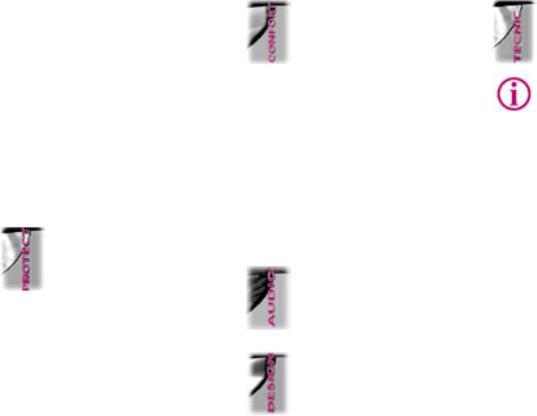
118 - Practical information
ACCESSORIES FOR YOUR 607
A wide range of accessories recommended by PEUGEOT and original parts are offered by the Network.
They all benefit from PEUGEOT's recommendation.
These accessories and parts, having been tested and approved for reliability and safety, are all adapted to your PEUGEOT vehicle.
The product range offered by PEUGEOT Accessories is structured around 5 categories: PROTECTION - TOURING - IN-CAR TECHNOLOGY - STYLING UNIVERSAL.
"Protection":
parking assistance, antitheft alarm, stolen vehicle tracking system*, engraved windows, locking wheel nuts, first aid kit, warning triangle, high visibility
safety jacket, snow chains.
Wheels which are fitted with 235/ 45 R 18 tyres cannot be fitted with snow chains. For further information, contact a PEUGEOT dealer.
 01-06-2005
01-06-2005
"Touring": covers compatible with side air bags, mats, boot tray, luggage retaining net, sill protectors.
For leisure pursuits: roof bars, transportation accessories (bicycle carrier, ski
carrier), roof box, child seats and booster cushions, rear screen blind, audio/telephone console, cool box.
Trailer towbar which must be fitted by the PEUGEOT Network.
Note
To prevent the mat from becoming caught under the pedals:
-ensure that the mat is positioned and secured correctly,
-never fit one mat on top of another.
"In-Car Technology": telephone, hands-free kits, satellite navigation systems, CD changer, DVD player, video screen.
"Styling": alloy wheels, wheel trims, spoiler, leather gear lever knob, styling strips, door spoilers, sport exhaust.
"Universal": windscreen wash fluid, interior and exterior cleaning and maintenance products.
The fitting of electrical equipment or accessories which are not recommended by PEUGEOT may result in a failure of your ve-
hicle's electronic system.
Please note this specific warning. You are advised to contact a representative of the Marque to be shown the range of recommended equipment and accessories.
Compatible portable equipment
For the Audio RD4, the fitting of an auxiliary socket is offered specifically by the Network.
The audio cable for connection to the auxiliary socket is also offered by the
Network.
Following connection of the cable and selection of the AUX mode, by means of the source button, your portable equipment is ready for use.
Set the portable equipment to half volume to avoid overloading the audio equipment sound. Then use the audio equipment volume button.
* According to country.

Technical data - 119
ENGINES AND GEARBOXES
MODELS: |
|
PETROL |
DIESEL |
||
|
XFV6 - XFVJ |
|
|
||
Model codes 9U... |
3FYH |
RHLH |
RHRH |
||
XFVJ/D - XFVU/D |
|||||
|
|
|
|
||
ENGINES |
2.2 litre 16V |
3 litre 24V V6 Injection |
2 litre 16V Turbo |
||
Diesel HDI |
|||||
|
|
|
|||
Capacity (cm3) |
2 230 |
2 946 |
|
1 997 |
|
Bore x stroke (mm) |
86 x 96 |
87 x 82.6 |
85 x 88 |
||
Number of valves |
16 |
24 |
|
16 |
|
Max. power: EU standard (KW) |
120 |
155 |
93 |
100 |
|
Max. power at engine speed (rpm) |
5 875 |
6 000 |
|
4 000 |
|
Max. torque: EU standard (Nm) |
220 |
290 |
|
320 |
|
Max. torque at engine speed (rpm) |
4 150 |
3 750 |
|
2 000 |
|
Fuel |
Unleaded |
Unleaded |
|
Diesel |
|
Catalytic converter |
Yes |
Yes |
|
Yes |
|
Particle emission filter (PEF) |
No |
No |
|
Yes |
|
Electronic injection |
Yes |
Yes |
|
Yes |
|
GEARBOX |
Manual |
Automatic |
Manual |
||
(6-speed) |
(6-speed) |
(6-speed) |
|||
|
|||||
CAPACITIES (in litres) |
|
|
|
|
|
Engines (with filter replacement) |
- (1) |
4.75 (1)/5.25 (2) |
5.25 (1) |
||
(1) Draining by gravity - (2) Draining by suction |
|
|
|
|
|
01-06-2005 |
|
|
|
|
|

12 - Familiarisation
CRUISE CONTROL/SPEED LIMITER
Cruise control function
1.Selection/Switching off of the function.
2.Storing of a speed/Decreasing of the stored speed.
3.Storing of a speed/Increasing of the stored speed.
4.Deactivation/Recalling of the stored speed.
In order for it to be stored, the vehicle speed must be above 25 mph (40 km/h), with at least fourth gear engaged on the manual gearbox (second gear on the automatic gearbox).
: 92
Speed limiter function
1.Selection/Switching off of the function.
2.Decreasing of the speed.
3.Increasing of the speed.
4.Activation/Deactivation of the system.
Adjustments must be made with the engine running.
: 93
FRONT AND/OR REAR PARKING ASSISTANCE
A.Activation.
B.Detection.
C.Deactivation/Reactivation.
During parking manoeuvres, you are guided by an audible signal and/or a graphic on the multifunction display.
: 95
 01-06-2005
01-06-2005
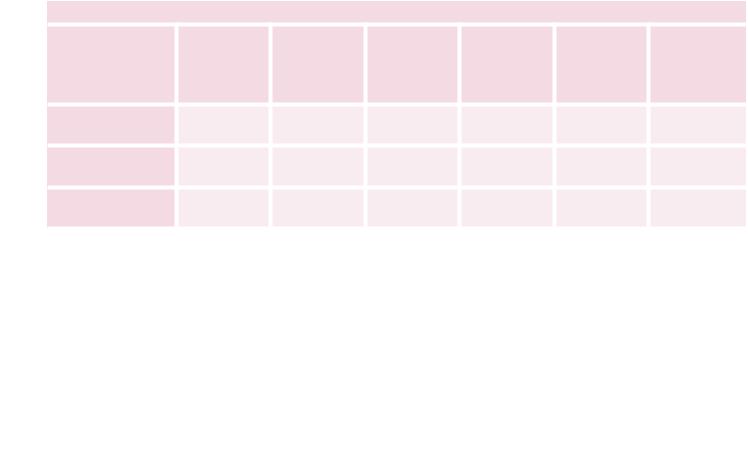
120 - Technical data
CONSUMPTION
As per EC Directive 80/1268 (as amended) in MPG (litres/100 km)
|
|
Model |
Urban driving |
Extra-urban |
Mixed driving |
Emission |
|
Engine |
Gearbox |
codes |
driving |
by mass of |
|||
(liter/100 km) |
(liter/100 km) |
||||||
|
|
9U... |
(liter/100 km) |
CO2 (g/km) |
|||
|
|
|
|
||||
2.2 litre 16V |
Manual |
3FYH |
21.7 (13.0) |
40.4 (7.0) |
30.7 (9.2) |
219 |
|
3 litre 24V V6 |
Automatic |
XFV6 - XFVJ |
19.0 (14.9) |
37.6 (7.5) |
27.2 (10.2) |
242 |
|
XFVJ/D - |
|||||||
injection |
|||||||
|
XFVU/D |
|
|
|
|
||
|
|
|
|
|
|
||
2 litre 16V |
Manual |
RHLH |
8.1 (34.9) |
5.0 (56.5) |
6.1 (46.3) |
162 |
|
turbo diesel HDI |
RHRH |
||||||
|
|
|
|
|
Fuel consumption values correct at time of printing. These consumption values were established in accordance with EC Directive 80/1268 (as amended). They may vary depending on the style of driving, traffic conditions, weather conditions, the load in the vehicle, the maintenance of the vehicle and the use of the accessories.
 01-06-2005
01-06-2005

|
|
|
Technical data - 121 |
||
WEIGHTS AND TOWING LOADS (in kg) |
|
|
|
|
|
|
|
PETROL |
DIESEL |
||
Engines |
2.2 litre 16V |
3 litre 24V |
2 litre 16V HDI |
||
|
V6 injection |
||||
|
|
|
|
||
Gearboxes |
Manual |
Automatic |
Manual |
||
Model codes: 9U... |
3FYH |
XFV6 - XFVJ |
RHLH |
RHRH |
|
XFVJ/D - XFVU/D |
|||||
|
|
|
|
||
• Kerb weight |
1 535 |
1 644 |
|
1 590 |
|
• Payload |
493 |
500 |
|
493 |
|
• Gross vehicle weight (GVW) |
2 028 |
2 144 |
|
2 083 |
|
• Gross train weight (GTW) |
|
|
|
|
|
on 12 % gradient |
3 628 |
3 644 |
|
3 583 |
|
on 8 % gradient |
3 828 |
3 944 |
|
3 883 |
|
• Braked trailer (within GTW limit) |
|
|
|
|
|
on 12 % gradient |
1 600 |
1 500 |
|
1 500 |
|
on 10 % gradient |
1 600 |
1 500 |
|
1 500 |
|
on 8 % gradient |
1 800 |
1 800 |
|
1 800 |
|
• Braked trailer* (with load transfer within |
1 850 |
1 800 |
|
1 760 |
|
GTW limit) |
|
||||
|
|
|
|
||
• Unbraked trailer |
750 |
750 |
|
750 |
|
• Recommended nose weight |
74 |
72 |
|
72 |
|
*The weight of the braked trailer may be increased, within the GTW limit, by the same amount by which the GVW of the towing vehicle is reduced; warning, towing with a lightly loaded towing vehicle may have an adverse effect on its road holding.
The GTW values and the towing loads indicated are valid for a maximum altitude of 1 000 metres; the towing load mentioned must be reduced by 10 % for every 1 000 additional metres.
The speed of a towing vehicle is limited to 60 mph (100 km/h)**.
High exterior temperatures may result in lowering of the performance of the vehicle in order to protect the engine; when the exterior temperature is above 45 °C, limit the towed load.
** according to the legislation in force in the country.
 01-06-2005
01-06-2005
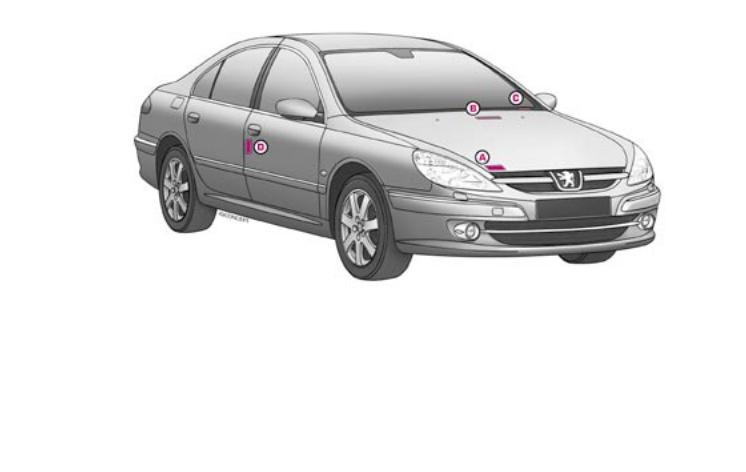
Technical data - 123
THE IDENTIFICATION FEATURES OF YOUR 607
A.Manufacturer's plate.
B.Serial number on the bodywork.
C.Serial number on the fascia.
D.Tyres.
Label D on the central door pillar on the driver's side indicates:
-the dimensions of the rims and tyres,
-the makes of tyre recommended by the manufacturer,
-the tyre pressures (checking of the tyre pressure must be carried out when the tyres are cold, at least once a month),
-the paint colour reference.
 01-06-2005
01-06-2005
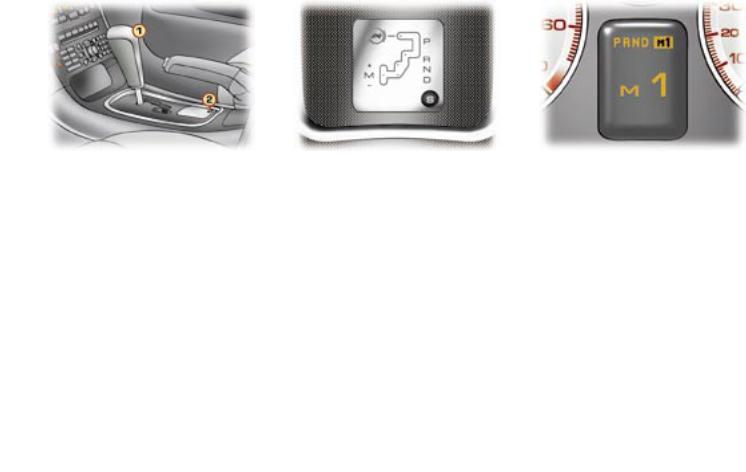
Familiarisation - 13
"PORSCHE TIPTRONIC SYSTEM" AUTOMATIC GEARBOX
1.Gear lever.
2."SPORT" button.
P : Park.
R : Reverse.
N : Neutral.
D : Drive.
M : Manual mode.
S : Sport programme.
1 2 3 4 5 6 : gears engaged.
Position selection gate
Move the lever in the gate to select one of the positions.
Once the position has been selected, the corresponding indicator light is displayed on the instrument panel display.
Indication on the instrument panel display
Switching the engine on
With the handbrake applied, select position P or N.
Switch on the ignition.
Moving off
With the engine running, from position P or N, with your foot on the brake, release the handbrake.
Select position R, D or M.
Release the brake pedal gradually; the vehicle moves off immediately.
: 89
 01-06-2005
01-06-2005
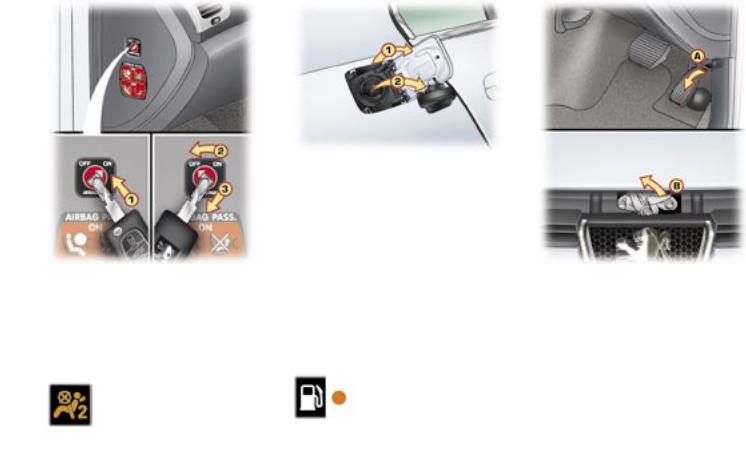
14 - Familiarisation
DISARMING THE PASSENGER AIR BAG*
1.Insertion of the key.
2.Selection of the "OFF" position.
3.Removal of the key retaining the position.
Passenger air bag disarmed
This warning light comes on on the instrument panel throughout the period of disarming.
* According to country.
: 85
FILLING WITH FUEL
1.Opening of the fuel filler flap.
2.Opening and hooking of the fuel tank cap.
Capacity of the fuel tank:
Approximately 80 litres.
Type of petrol:
Unleaded RON 95/RON 98.
Type of Diesel : Diesel.
Low fuel level
When this warning light comes on on the instrument panel, you have enough fuel left to drive approximately 30 miles (50 km).
: 69
OPENING THE BONNET
A.Internal control.
B.External control.
: 98
 01-06-2005
01-06-2005

Familiarisation - 15
AUDIO EQUIPMENT STEERING WHEEL CONTROL
Volume adjustment
1 - Increase by pressing the back
2 - Decrease by pressing the back
1+2 - Cutting off/Restoring of the sound
Search/Selection by pressing
3 - Higher radio frequency - CD/CD changer: next
4 - Lower radio frequency - CD/CD changer: previous
Sound sources
5 - Change of sound source
Access to the telephone displays
Selection of the stations/CDs in the changer by rotation
6 - Higher stored station - Next CD
7 - Lower stored station - Previous CD
 01-06-2005
01-06-2005
RD4 CONTROL PAD
Button (A)
ON/OFF and volume adjustment.
Button (B)
CD eject.
Keypad (1)
AUDIO: access to the radio displays.
SOURCE: change of source between radio, CD, CD changer.
TRIP: access to the trip computer displays.
BAND AST: selection of the frequency bands.
TEL: access to the hands-free kit displays.
DARK: 1st press: black screen under the banner - 2nd press: completely black screen - 3rd press: return to the display.
Keypad (2)
ESC (Escape): cancellation of the operation in progress.
MENU: displaying of the general menu.
¯: access to the musical ambience settings.
Keypad (3)
Navigator.
Keypad (4)
TA: traffic information priority on/off.
LIST: displaying of the list of stations received, of the tracks on the CD.
PTY: access to the search by type of programme.
Keypad (5)
Storing of the radio station.
Selection of the stored station, of the CD in relation to the position in the
CD changer.
: Audio and telematics
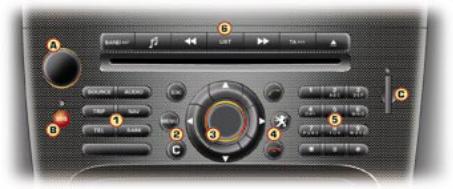
16 - Familiarisation
RT3 CONTROL PAD
Button (A)
ON/OFF and volume adjustment.
Button (B)
Emergency call.
Keypad (1)
AUDIO: access to the radio displays.
SOURCE: change of source between radio, CD, CD changer.
TRIP: access to the trip computer displays.
NAV: access to the navigation - guidance displays.
TEL: access to the telephone displays.
DARK: 1st press: black screen under the banner - 2nd press: completely black screen - 3rd press: return to the display.
Keypad (2)
ESC (Escape): cancellation of the operation in progress.
MENU: displaying of the general menu.
C: deletion of the last character entered or of the entire line.
 01-06-2005
01-06-2005
Keypad (3)
Navigator.
Movement by rotation of the dial or by pressing the arrows.
Confirmation or displaying of the contextual menus by pressing the dial.
Keypad (4)
TEL (green): pick up an incoming call.
LION: access to the PEUGEOT services menu.
TEL (red): hang up.
Keypad (5)
Storing of the radio station.
Selection of the stored station, of the CD in relation to the position in the CD changer.
Telephone keypad - alphanumeric keypad for entering the descriptions.
Keypad (6)
Audio - CD player controls bar.
Location (C)
SIM card flap.
: Audio and telematics
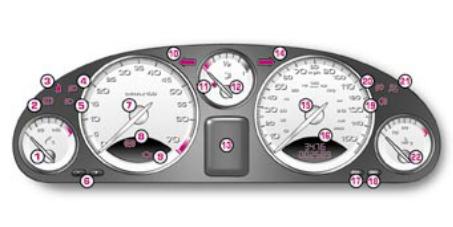
PETROL MANUAL AND AUTOMATIC GEARBOXES INSTRUMENT PANEL
1 - Engine oil temperature indicator.
2 - Handbrake, low brake fluid level and electronic brake force distribution warning light.
3 - Driver's seat belt not fastened warning light.
4 - Dipped headlamps indicator light.
5 - Main beam headlamps indicator light.
6 - Lighting rheostat buttons.
 01-06-2005
01-06-2005
7 - Rev counter.
8 - Anti-lock braking system
(ABS) warning light.
9 - Emission control system warning light.
10-Left direction indicator.
11- Low fuel level warning light.
12-Fuel gauge.
Instruments and controls - 17
13 -Functions display screen:
-Check.
-Engine oil level gauge.
-Warning and status indicator lights.
-Cruise control/speed limiter.
-Automatic gearbox.
-Trip computer.
-Satellite navigation system.
14 -Right direction indicator.
15 -Speedometer.
16 -Service indicator, total and trip distance recorders.
17 -Trip distance recorder zero reset button.
18 -Manual check button.
19 -Rear fog lamps indicator light.
20 -Front fog lamps indicator light.
21 -Passenger air bag disarmed warning light*.
22 -Coolant temperature indicator.
* According to country.
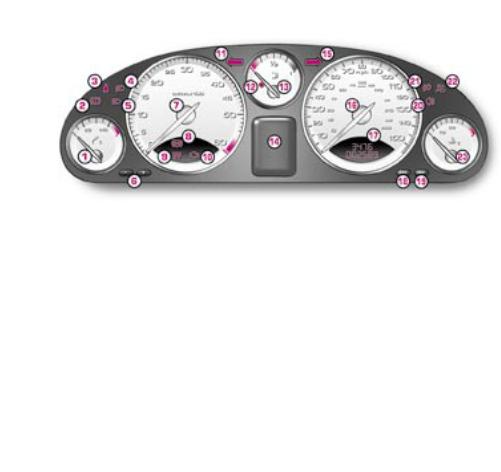
18 - Instruments and controls
DIESEL MANUAL AND AUTOMATIC GEARBOXES INSTRUMENT PANEL
1 - Engine oil temperature indicator.
2 - Handbrake, low brake fluid level and electronic brake force distribution warning light.
3 - Driver's seat belt not fastened warning light.
4 - Dipped headlamps indicator light.
5 - Main beam headlamps indicator light.
6 - Lighting rheostat buttons.
 01-06-2005
01-06-2005
7 - Rev counter.
8 - Anti-lock braking system (ABS) warning light.
9 - Diesel engine pre-heating warning light.
10 -Emission control system warning light.
11 - Left direction indicator.
12 -Low fuel level warning light.
13 -Fuel gauge.
14 -Functions display screen:
-Check.
-Engine oil level gauge.
-Warning and status indicator lights.
-Cruise control/speed limiter.
-Automatic gearbox.
-Trip computer.
-Satellite navigation system.
15 -Right direction indicator.
16-Speedometer.
17-Service indicator, total and trip distance recorders.
18-Trip distance recorder zero reset button.
19-Manual check button.
20-Rear fog lamps indicator light.
21-Front fog lamps indicator light.
22-Passenger air bag disarmed warning light*.
23-Coolant temperature indicator.
* According to country.
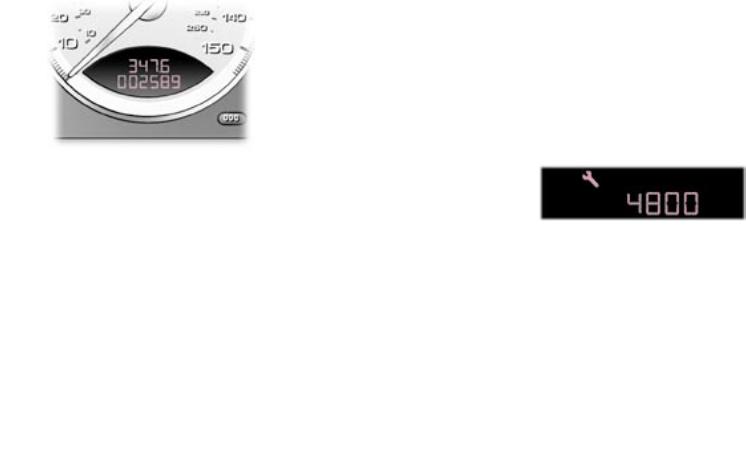
30 - Instruments and controls
INSTRUMENT PANEL DISPLAY
After switching on the ignition, two functions are shown in succession:
-service indicator,
-total distance recorder (total and trip distances).
Note: the total and trip distances are displayed for 30 seconds when the ignition is switched off, on opening the driver's door, as well as on locking and unlocking the vehicle.
Service indicator
This is a visual reminder of when the next service is due. This service is to be carried out according to the manufacturer's servicing schedule.
The point at which the service is due is calculated from the last indicator zero reset. It is determined by two parameters:
-the distance travelled,
-the time elapsed since the last service.
Note: the distance remaining before the next service is due may be weighted by the time factor.
The service information appears on the display, located in the speedometer dial, at the same time as the engine oil level on the instrument panel display.
Operation
As soon as the ignition is switched on and for 7 seconds, the spanner symbolising ''service operation'' is lit. The trip recorder display shows the distance remaining (in round figures) before the next service.
Example: 4,800 miles/km remain before the next service is due.
When the ignition comes on and for 7 seconds the display indicates:
7 seconds after the ignition is switched on, the total distance recorder resumes normal operation and the display shows the total and trip distances.
 01-06-2005
01-06-2005
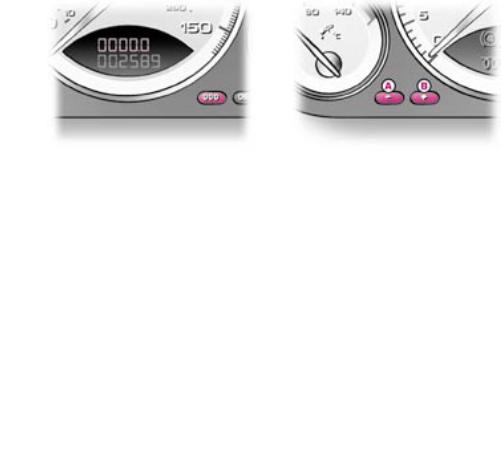
32 - Instruments and controls
Trip recorder zero reset button
With the ignition on, press the button until the zeros appear.
Lighting rheostat button
With the headlamps on, press button B to increase the brightness of the lighting of the instruments and controls or button A to reduce it.
As soon as the lighting reaches the required level of brightness, release the button.
 01-06-2005
01-06-2005

Instruments and controls - 33
TRIP COMPUTER |
Colour screen C |
Colour and map screen DT |
|
|
|
|
|
|
Each press on the button, located at the end of the wipers stalk, displays different trip computer data in succession, depending on the multifunction display:
- the "vehicle" tab with:
•the range, the current consumption and the distance remaining to be travelled,
- tab "1" (route 1) with:
•the average speed, the average consumption and the distance travelled calculated over route "1",
-tab "2" (route 2) with the same characteristics for a second route.
- the "Current info" with:
•the range, the current consumption and the distance remaining to be travelled,
- "Route 1" with:
•the distance travelled, the average consumption and the average speed calculated over route "1",
-"Route 2" with the same characteristics for a second route.
 01-06-2005
01-06-2005
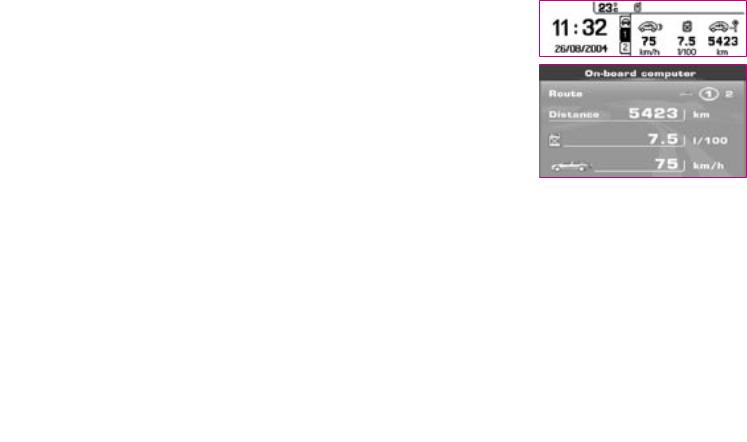
34 - Instruments and controls
Range (km or miles)
This shows the distance that can still be covered with the fuel remaining in the tank in accordance with the average consumption over the last few miles (kilometres).
This figure may increase if there is a change in the style of driving or the road surface, producing a significant drop in current consumption.
When the range is less than 30 miles
(50 km), four dashes are displayed. After filling with fuel, the range is displayed when it exceeds 62 miles (100 km).
If dashes are displayed for long periods instead of digits, contact a PEUGEOT dealer.
Current consumption (l/100 or km/l or mpg)
This is the average quantity of fuel consumed during the last few seconds.
This function is displayed only when the vehicle is travelling at a speed greater than 20 mph (30 km/h).
Average consumption (l/100 or km/l or mpg)
This is the average fuel consumption since the computer was last set to zero.
 01-06-2005
01-06-2005
Distance travelled (km or miles)
This indicates the distance travelled since the computer was last set to zero.
Distance remaining to be travelled (km or miles)
This is the distance remaining to be travelled to the final destination. It is either calculated by the navigation system if guidance is activated or entered by the user.
If the distance is not entered, dashes are displayed in place of the digits.
Average speed (km/h or mph)
This is the average speed calculated since the computer was last set to zero (with the ignition on).
The routes
The routes "1" and "2" are independent but have identical application.
Route "1" for example allows you to make daily calculations and route "2" monthly calculations.
Zero reset
When the required route is displayed, press the end of the wipers stalk for more than two seconds.
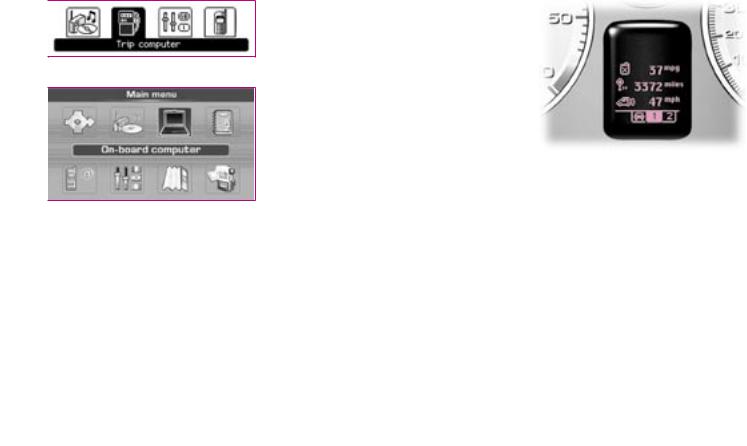
Access via the general menu
C screen
DT screen
"TRIP" menu
Press the "MENU" or "TRIP" button to gain access to the general menu.
Select the "Trip computer" application using the navigator, then confirm.
The "Trip computer" menu offers various options:
-Inputting of the distance to be travelled,
-Warnings log,
-Status of the functions.
Warnings log
This summarises the active warning messages, displaying them on the multifunction display in succession.
Status of the functions
This summarises the active or inactive status of the functions present on the vehicle.
Inputting the distance remaining to be travelled
When guidance is not activated, this enables you to enter an approximate distance to the final destination.
Instruments and controls - 35
Indication on the instrument panel display
The different trip computer data also appears on the instrument panel display at the same time.
 01-06-2005
01-06-2005
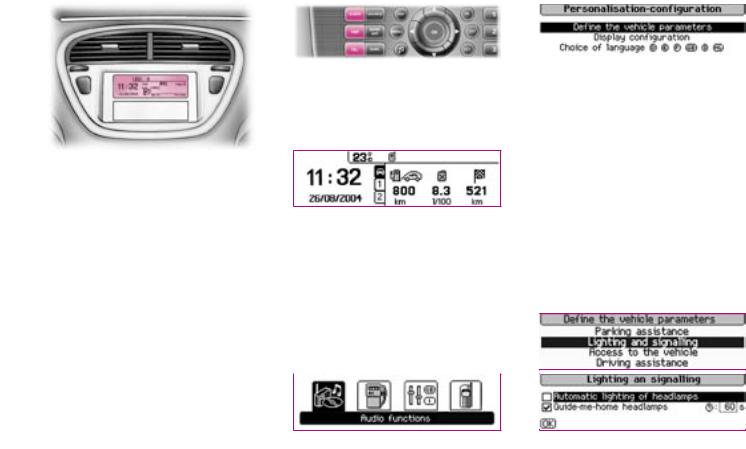
36 - Multifunction displays
COLOUR SCREEN C |
Management of the displays |
"Personalisation-Configuration" |
|
|
menu |
|
|
|
This displays the following information, via the RD4 audio equipment control pad:
-the time,
-the date,
-the exterior temperature (the value displayed flashes if there is a risk of ice),
-the accesses check,
-the vehicle functions warning or status messages, displayed temporarily,
-the audio sources displays,
-the trip computer displays,
-the personalisation and configuration displays,
-the hands-free kit displays.
The "AUDIO", "TRIP" and "TEL" buttons on the RD4 audio equipment control pad permit displaying in the main window.
Example: "TRIP"
General menu
Press the "MENU" button to gain access to the general menu and select one of the following functions:
-"Audio functions",
-"Trip computer",
-"Personalisation-Configuration",
-"Telephone".
Example: "Audio functions"
This provides access to successive confirmation windows.
Defining the vehicle parameters
This enables you to activate or deactivate certain driving and comfort elements:
-"Automatic switching on of the lights",
-"Follow-me-home lighting" and "Duration",
-"Remote control action",
-"Permanent locking of the boot".
Example: "Automatic switching on of the lights"
 01-06-2005
01-06-2005

Selection of the language
German, Spanish, French, English, Italian, Dutch, Portuguese and Brazilian Portuguese.
Configuration of the display
-"Setting the brightness-video".
-"Setting the date and time".
-"Selection of the units":
•temperature (°C or °F),
•fuel consumption (l/100, mpg or km/l).
-"Selection of the colours".
 01-06-2005
01-06-2005
Changing the date and time
From the general menu, select the
"Personalisation-Configuration" icon using the navigator, then confirm.
From the list displayed, select "Configuration of the display", then confirm.
From the list displayed, select
"Setting the date and time", then confirm.
Multifunction displays - 37
Set the parameters one by one:
-the zone selected is displayed on the screen,
-use the navigator to move from one zone to another,
-your new parameters are confirmed one by one, by pressing the navigator button,
-all of the changes are saved, if you click on "OK" on the screen, or cancelled, if you press the "ESC" button on the control pad.
For safety reasons, configuration of the multifunction displays by the driver must be carried out while stationary.
